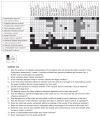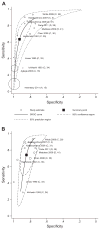Accuracy of pupil assessment for the detection of glaucoma: a systematic review and meta-analysis
- PMID: 23809274
- PMCID: PMC3818414
- DOI: 10.1016/j.ophtha.2013.04.012
Accuracy of pupil assessment for the detection of glaucoma: a systematic review and meta-analysis
Abstract
Objective: To assess the accuracy of using pupillary light reflex (PLR) in detecting glaucoma.
Clinical relevance: Glaucoma is a specific disease of the optic nerve and is often more severe in 1 eye. When large enough, this asymmetry in disease severity can cause a relative afferent pupillary defect (RAPD). Better detection of RAPDs may be one way to identify persons with glaucoma.
Methods: We searched Medline and Embase through June 2012 and searched bibliographies for relevant studies for additional references. Two authors independently reviewed all articles and selected studies that assessed PLRs in patients with glaucoma. We analyzed data using mixed-effect bivariate summary receiver operating characteristic meta-analysis models.
Results: A total of 30 studies were included in this review. An RAPD was observed in 9% to 82% of patients with glaucoma. Eleven studies with a total of 7271 participants were included in the analysis, and the pooled estimate corresponded to a sensitivity of 0.63 (95% confidence interval [CI], 0.43-0.80) and a specificity of 0.93 (95% CI, 0.85-0.97). After excluding 2 studies that used the swinging flashlight test, the sensitivity increased to 0.74 (95% CI, 0.59-0.85) with a specificity of 0.85 (95% CI, 0.77-0.90). Study designs and different pupil measurement techniques explained part of the heterogeneity between studies.
Conclusions: Patients with glaucoma frequently have an abnormal PLR and comparing the responses between the 2 eyes can in part distinguish between those with glaucoma and those without the disease. Newer instruments and analytic approaches to assess pupil function may improve the performance of pupil screening.
Copyright © 2013 American Academy of Ophthalmology. Published by Elsevier Inc. All rights reserved.
Figures




Similar articles
-
Signs and symptoms to determine if a patient presenting in primary care or hospital outpatient settings has COVID-19.Cochrane Database Syst Rev. 2022 May 20;5(5):CD013665. doi: 10.1002/14651858.CD013665.pub3. Cochrane Database Syst Rev. 2022. PMID: 35593186 Free PMC article.
-
Optic nerve head and fibre layer imaging for diagnosing glaucoma.Cochrane Database Syst Rev. 2015 Nov 30;2015(11):CD008803. doi: 10.1002/14651858.CD008803.pub2. Cochrane Database Syst Rev. 2015. PMID: 26618332 Free PMC article.
-
Clinical symptoms, signs and tests for identification of impending and current water-loss dehydration in older people.Cochrane Database Syst Rev. 2015 Apr 30;2015(4):CD009647. doi: 10.1002/14651858.CD009647.pub2. Cochrane Database Syst Rev. 2015. PMID: 25924806 Free PMC article.
-
Three-dimensional saline infusion sonography compared to two-dimensional saline infusion sonography for the diagnosis of focal intracavitary lesions.Cochrane Database Syst Rev. 2017 May 5;5(5):CD011126. doi: 10.1002/14651858.CD011126.pub2. Cochrane Database Syst Rev. 2017. PMID: 28472862 Free PMC article.
-
Regional cerebral blood flow single photon emission computed tomography for detection of Frontotemporal dementia in people with suspected dementia.Cochrane Database Syst Rev. 2015 Jun 23;2015(6):CD010896. doi: 10.1002/14651858.CD010896.pub2. Cochrane Database Syst Rev. 2015. PMID: 26102272 Free PMC article.
Cited by
-
Subtype-specific survival and regeneration of retinal ganglion cells in response to injury.Front Cell Dev Biol. 2022 Aug 12;10:956279. doi: 10.3389/fcell.2022.956279. eCollection 2022. Front Cell Dev Biol. 2022. PMID: 36035999 Free PMC article. Review.
-
Binocular head-mounted chromatic pupillometry can detect structural and functional loss in glaucoma.Front Neurosci. 2023 Jun 29;17:1187619. doi: 10.3389/fnins.2023.1187619. eCollection 2023. Front Neurosci. 2023. PMID: 37456990 Free PMC article.
-
Factors influencing the pupillary light reflex in healthy individuals.Graefes Arch Clin Exp Ophthalmol. 2016 Jul;254(7):1353-9. doi: 10.1007/s00417-016-3311-4. Epub 2016 Mar 12. Graefes Arch Clin Exp Ophthalmol. 2016. PMID: 26968720
-
Detection of Relative Afferent Pupillary Defect and Its Correlation with Structural and Functional Asymmetry in Patients with Glaucoma Using Hitomiru, a Novel Hand-Held Pupillometer.J Clin Med. 2023 Jun 8;12(12):3936. doi: 10.3390/jcm12123936. J Clin Med. 2023. PMID: 37373631 Free PMC article.
-
Symmetry of the pupillary light reflex and its relationship to retinal nerve fiber layer thickness and visual field defect.Invest Ophthalmol Vis Sci. 2013 Aug 19;54(8):5596-601. doi: 10.1167/iovs.13-12142. Invest Ophthalmol Vis Sci. 2013. PMID: 23860751 Free PMC article.
References
-
- Wang JC, Gazzard G, Foster PJ, et al. Interocular asymmetry of visual field defects in primary open angle glaucoma and primary angle-closure glaucoma. Eye (Lond) 2004;18:365–8. - PubMed
-
- Kalaboukhova L, Fridhammar V, Lindblom B. Relative afferent pupillary defect in glaucoma: a pupillometric study. Acta Ophthalmol Scand. 2007;85:519–25. - PubMed
-
- Thompson HS, Corbett JJ, Cox TA. How to measure the relative afferent pupillary defect. Surv Ophthalmol. 1981;26:39–42. - PubMed
Publication types
MeSH terms
Grants and funding
LinkOut - more resources
Full Text Sources
Other Literature Sources
Medical

